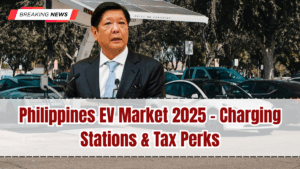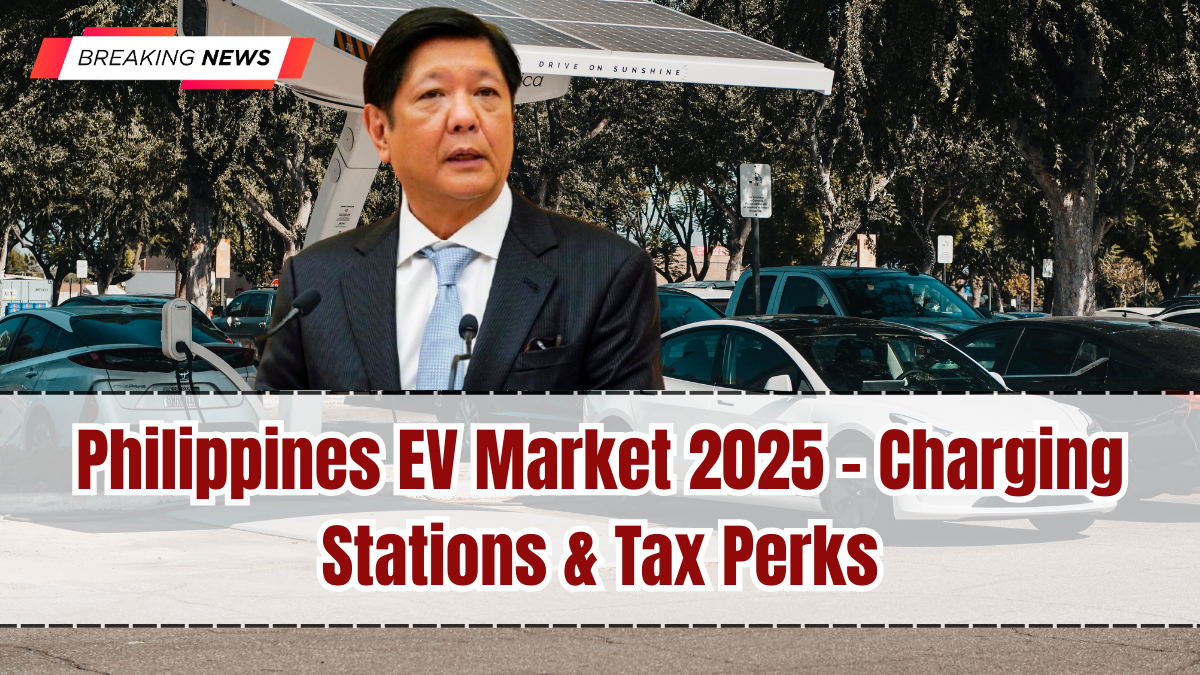The Philippines EV Market 2025 is experiencing its strongest momentum yet. Rising fuel prices, government incentives, and the global shift toward sustainability have pushed more Filipinos to consider electric vehicles.
For years, EV adoption in the Philippines lagged behind other Southeast Asian countries due to limited infrastructure and high costs. But with new charging stations being rolled out and tax perks introduced, the EV landscape is finally changing.

How Many Charging Stations Are Now Available in the Philippines?
In 2025, the Department of Energy (DOE) confirmed the installation of over 400 public charging stations nationwide.
-
Metro Manila: Shopping malls, business districts, and expressways now host fast-charging hubs.
-
Cebu and Davao: Expansion into regional cities ensures EV adoption is not limited to the capital.
-
Expressway Stops: Charging points along NLEX and SLEX make long-distance EV travel more practical.
Private companies like SM Malls, Ayala Land, and Shell Recharge are also investing heavily, providing fast-charging facilities in prime locations.
What Types of Chargers Are Being Deployed?
The Philippine EV network now includes:
-
AC Slow Chargers (7–22kW): Common in malls and workplaces, good for overnight or long-stop charging.
-
DC Fast Chargers (50–150kW): Found along expressways, capable of charging most EVs to 80% in under 40 minutes.
-
Ultra-Fast Chargers (350kW): Limited but being tested in select premium hubs, catering to high-performance EVs.
This mix ensures that both daily commuters and long-distance drivers are supported.
What Tax Incentives Are Available for EV Buyers?
To accelerate adoption, the Philippine government introduced several perks under the Electric Vehicle Industry Development Act (EVIDA) and new 2025 updates:
-
Excise Tax Exemption: EVs remain exempt from excise tax until 2030.
-
Import Duty Reductions: Selected EVs benefit from reduced import tariffs, making them cheaper than in previous years.
-
Value-Added Tax (VAT) Relief: Some categories of EVs, especially entry-level models, receive VAT reductions.
-
Corporate Incentives: Businesses investing in EV fleets can deduct additional expenses for charging infrastructure.
These measures make EVs more accessible to both individuals and businesses.
Which EV Models Are Popular in the Philippines in 2025?
The local market now offers a wide range of models across different price segments:
-
Affordable Options: BYD Dolphin, Nissan Leaf, Wuling Air EV.
-
Mid-Range EVs: Hyundai Ioniq 6, MG4 EV, Kia EV6.
-
Premium Models: Tesla Model 3, BMW iX, Porsche Taycan.
Among these, the BYD Dolphin stands out as the best-selling affordable EV, appealing to families and first-time buyers.
How Are Businesses and Fleets Adopting EVs?
It’s not just private buyers driving adoption—businesses are also making the shift.
-
Logistics Companies: Lalamove and Grab are piloting EV delivery fleets.
-
Taxi Operators: Metro Manila taxi cooperatives are testing Nissan Leaf fleets.
-
Corporate Fleets: Multinational firms are transitioning staff vehicles to EVs to meet sustainability goals.
This corporate push is helping normalize EV use across the country.
Are Filipinos Ready for EV Adoption?
While infrastructure is improving, challenges remain:
-
High Upfront Costs: Even with tax breaks, EVs are still more expensive than comparable gasoline models.
-
Charging Convenience: Rural areas still lack enough charging points.
-
Battery Concerns: Many Filipinos remain cautious about battery lifespan and replacement costs.
Despite these concerns, surveys show a growing willingness to shift—especially among younger buyers and middle-class families seeking long-term savings on fuel.
What Role Does the Government Play in 2025?
The government has taken a proactive stance:
-
Mandated Charging Points: New malls, gas stations, and parking complexes must allocate EV charging slots.
-
Fleet Conversion Targets: Government agencies are required to convert a portion of their fleets to EVs by 2028.
-
Public Transport Electrification: Pilot projects for electric jeepneys and buses are underway in Metro Manila.
This multi-pronged approach shows that EV adoption is no longer just optional—it is part of a national strategy.
How Do EVs Compare with Petrol Cars in Daily Costs?
Even though upfront prices remain higher, EVs now save drivers significantly on running costs.
-
Fuel Savings: Charging an EV costs 40–60% less than fueling with gasoline.
-
Maintenance: EVs have fewer moving parts, lowering annual maintenance expenses by 20–30%.
-
Road Tax: Under revised LTO rules, EVs enjoy lower annual road tax compared to petrol cars of similar size.
For families driving daily in Metro Manila, these savings add up to ₱50,000–₱70,000 per year.
What’s the Outlook for the Philippine EV Market?
By 2030, analysts expect EVs could make up 15–20% of new car sales in the country.
In 2025 alone, EV registrations have doubled compared to 2024, showing clear signs of momentum. With continuous investments in charging infrastructure and government support, adoption is set to accelerate further.
Conclusion
The Philippines EV Market 2025 is at a turning point. With hundreds of charging stations now live, strong tax incentives, and a wider range of models available, Filipinos are finally embracing electric mobility.
Challenges like upfront costs and rural charging gaps remain, but the benefits of long-term savings, sustainability, and convenience are winning drivers over. For families, businesses, and the government alike, the EV revolution is no longer a dream—it’s becoming a daily reality in the Philippines.
FAQs
How many charging stations are available in the Philippines in 2025?
There are now over 400 public charging stations, mostly in Metro Manila, Cebu, and Davao.
What tax perks do EV buyers enjoy in 2025?
Buyers benefit from excise tax exemptions, reduced import duties, VAT relief, and fleet incentives.
Which EV is the most affordable in the Philippines this year?
The BYD Dolphin is currently the cheapest full EV available, making it very popular among first-time buyers.
Are EVs cheaper to run than petrol cars?
Yes. Charging costs 40–60% less than fuel, and annual maintenance is also lower by up to 30%.
What is the government’s long-term plan for EVs?
The Philippines targets broader adoption by 2030, with required charging stations, EV fleets in government offices, and pilot programs for electric jeepneys and buses.
Click here to know more.
